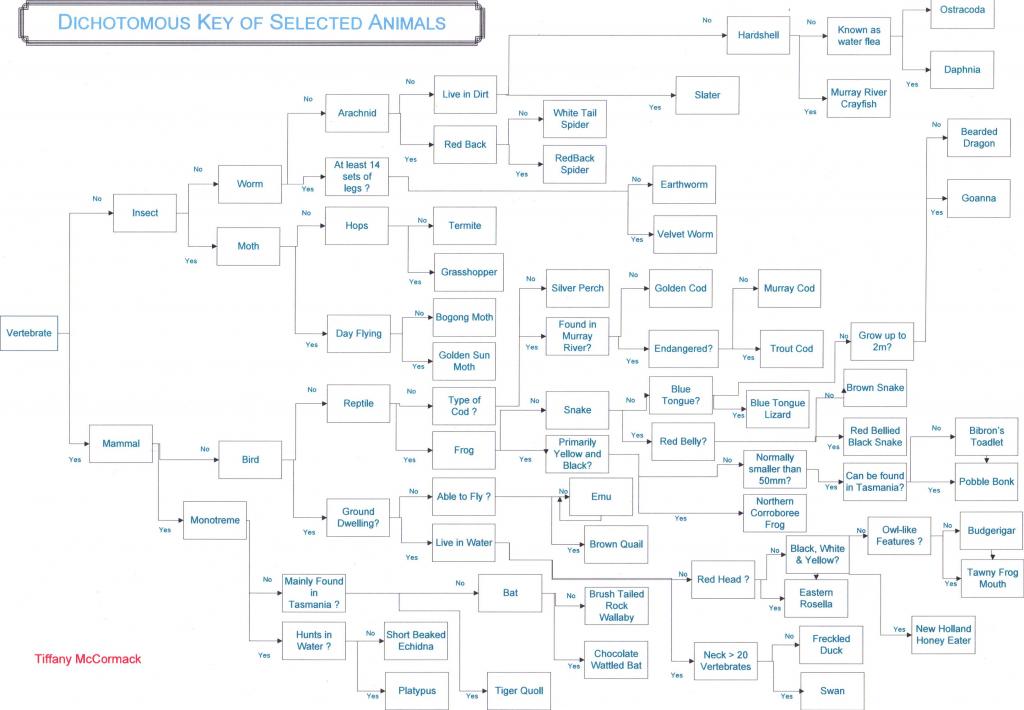Year 7 Science Assignment: Part C
Dichotomous key report on selected animals
This experiment is all about creating a dichotomous key that includes all the animals provided and writing a scientific report on it.
Aim-
To create a dichotomous key that includes all selected animals and is easy to read and follow.
Hypothesis-
My hypothesis is that through a series of questioning based around categories and distinguishing features, all animals can be mapped along unique paths.
Apparatus-
- Pen/pencil
- A3 sheet of paper
- Sheet of paper
- List of animals
Method-
To make my dichotomous key I firstly wrote down all that I knew about each animal on a piece of paper. This helped me identify the questions I wanted to pose in order to create a successful dichotomous key.
I approached this task through a series of questioning on whether the animals did or did not align with certain categories or distinguishing features. Depending on whether they aligned or not, I followed through with further lines of questioning against more categories until each animal was mapped. I began this mapping with broader categories or groups, and worked my way through a series of yes and no questions that progressively became more specific.
For instance, the line of questioning that mapped the Platypus started with the general category ‘vertebrate’ and went through ‘mammal’, ‘monotreme’ then to the question does it ‘hunt in water?’ Through answering yes to all these topics the Platypus was identified as the only animal from the list to fit all these descriptors.
The map is presented as a flow chart with the more general questions on the left moving to the more detailed questions and the aligned animals on the right.
The number of categories or questions I used to map all the animals was 37.
Results-

Discussion-
I found while doing this experiment that most of the animals were relatively easy to place in the key, although for some animals further research was required at home. The hardest animal to put in the key was the Murray River Crayfish because I didn’t know much about it and the picture was not very informative. I did not know whether it was a fish or not, and this made classifying it hard. I later found that it is not a fish, but a Crustacean. I also had trouble with this animal, as I didn’t know if it was a mammal, fish or crustacean. These factors all made making the key hard but I ended up getting through the challenges.
I learned that although the name of an animal can in most instances assist in the dichotomous key process, it is not always the case. Sometimes animal names do not accurately reflect the real categorisation of the animal. For instance, Bibron’s Toadlet is not a toad, as I would have expected. Rather, it is a frog. Also, the task required a certain amount of knowledge about the animals in order to develop questions that would be appropriate for the mapping process. Often research on the animals was needed in order to develop sensible questions.
When I was given two extra animals to map, I found them relatively easy to add into the key and the only change I had to make to my key was adding in the question, is it “known as a water flee?” It also helped that I already knew what the animals were so I did not find them hard to classify and add into my dichotomous key.
If, in the future, I knew I had to add more animals to the key, I would leave empty boxes, that I could complete at a later date, adding in new questions and animals.
I can imagine that when the Platypus was discovered it would have been hard for scientists to classify, as it looks like many things, such as a mixture between a duck and a beaver. Scientists would also not have known whether it was a reptile, mammal, unusual looking fish or a new type of group of classification no one had discovered before. All these factors would mean that they wouldn’t have known how to classify it or what it was.
Conclusion-
After creating my dichotomous key I have come to the conclusion that the key has a factual series of questioning and all animals have been correctly classified and can be found if you follow each individual path.

